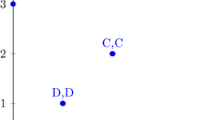Abstract
Foraging theory is typically used to model animal decision making. We describe an agent such as an autonomous vehicle or software module as a forager searching for tasks. The prey model is used to predict which types of tasks an agent should choose to maximize its rate of reward, and the patch model is used to predict when an agent should leave a patch of tasks and how to choose within-patch search patterns. We expand and apply these concepts to fit an autonomous vehicle control problem and to provide insight into how to make high-level control decisions. We also discuss extensions of the basic models, showing how a risk-sensitive version can be used to alter policies when time or fuel is limited. Throughout the applications, we examine ways an agent can estimate environmental parameters when such parameters are not known.
Similar content being viewed by others
References
Stephens, D.W., Krebs, J.R.: Foraging Theory. Princeton University Press, Princeton, NJ (1986)
Houston, A.I., McNamara, J.M.: Models of Adaptive Behaviour. Cambridge University Press, Cambridge, UK (1999)
Clark, C.W., Mangel, M.: Dynamic State Variable Models in Ecology. Oxford University Press, New York (2000)
Passino, K.M.: Biomimicry for Optimization, Control, and Automation. Springer, London (2005)
Passino, K.M.: Biomimicry of bacterial foraging for distributed optimization and control. IEEE Control Syst. Mag. 22(3), 52–67 (2002)
Chandler, P.R., Pachter, M.: Research issues in autonomous control of tactical UAVs. In: Proceedings of the American Control Conference, Philadelphia, Pennsylvania, pp. 394–398, 24–26 June 1998
Quijano, N., Gil, A.E., Passino, K.M.: Experiments for dynamic resource allocation, scheduling, and control. IEEE Control Syst. Mag. 25(1), 63–79 (2005)
McNamara, J.M., Houston, A.I.: Risk-sensitive foraging: a review of the theory. B. of Math. Biol. 54(2/3), 355–378 (1992)
Houston, A.I., McNamara, J.M.: The choice of two prey types that minimises the probability of starvation. Behav. Ecol. Sociobiol. 17, 135–141 (1985)
Stephens, D.W., Charnov, E.L.: Optimal foraging: some simple stochastic models. Behav. Ecol. Sociobiol. 10, 251–263 (1982)
Jacques, D.R., Leblanc, R.: Effectiveness analysis for wide area search munitions. In: Proceedings of the AIAA Missile Sciences Conference, Monterey, CA, 17–19 Nov 1998
Jacques, D.R., Gillen, D.P.: Cooperation behavior schemes for improving the effectiveness of autonomous wide area search munitions. In: Murphey, R., Pardalos, P.M. (eds.) Cooperative Control and Optimization, vol. 66, pp. 95–120. Kluwer, Boston, MA (2002)
Stone, L.D.: Theory of Optimal Search. Academic, New York (1975)
McNamara, J.M.: Control of a diffusion by switching between two drift-diffusion coefficient pairs. SIAM J. Control Optim. 22(1), 87–94 (1984)
Quijano, N., Andrews, B.W., Passino, K.M.: Foraging theory for multizone temperature control. IEEE Comput. Intell. Mag. 1(4), 18–27 (2006)
McNamara, J.M., Houston, A.I., Collins, E.J.: Optimality models in behavioral biology. SIAM Rev. 43(3), 413–466 (2001)
Dukas, R.: Constraints on information and their effects on behavior. In: Dukas, R. (ed.) Cognitive Ecology: The Evolutionary Ecology of Information Processing and Decision Making, pp. 89–127. University of Chicago Press, Chicago, IL (1998)
Andrews, B.W., Passino, K.M., Waite, T.A.: Social foraging theory for robust multiagent system design. IEEE Trans. Autom. Sci. Eng. 4(1), 79–86 (2007)
Giraldeau, L., Caraco, T.: Social Foraging Theory. Princeton University Press, Princeton, NJ (2000)
Author information
Authors and Affiliations
Corresponding author
Rights and permissions
About this article
Cite this article
Andrews, B.W., Passino, K.M. & Waite, T.A. Foraging Theory for Autonomous Vehicle Decision-making System Design. J Intell Robot Syst 49, 39–65 (2007). https://doi.org/10.1007/s10846-007-9138-9
Received:
Accepted:
Published:
Issue Date:
DOI: https://doi.org/10.1007/s10846-007-9138-9




